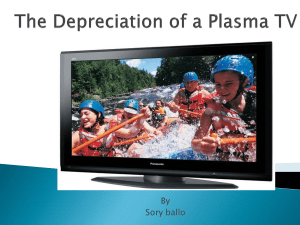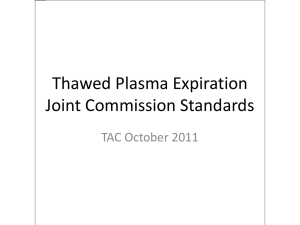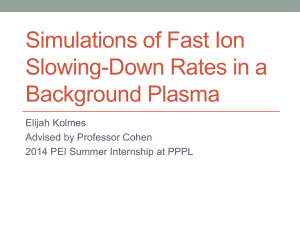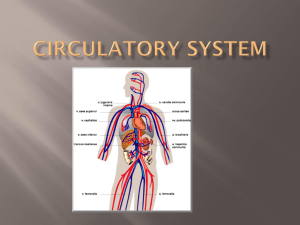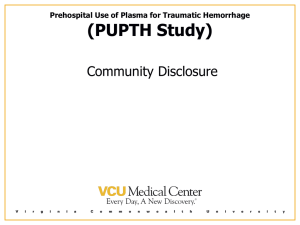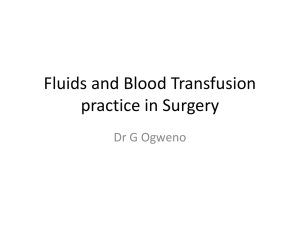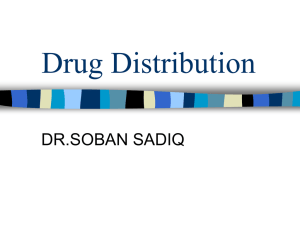PPT - DOE Plasma Science Center
advertisement
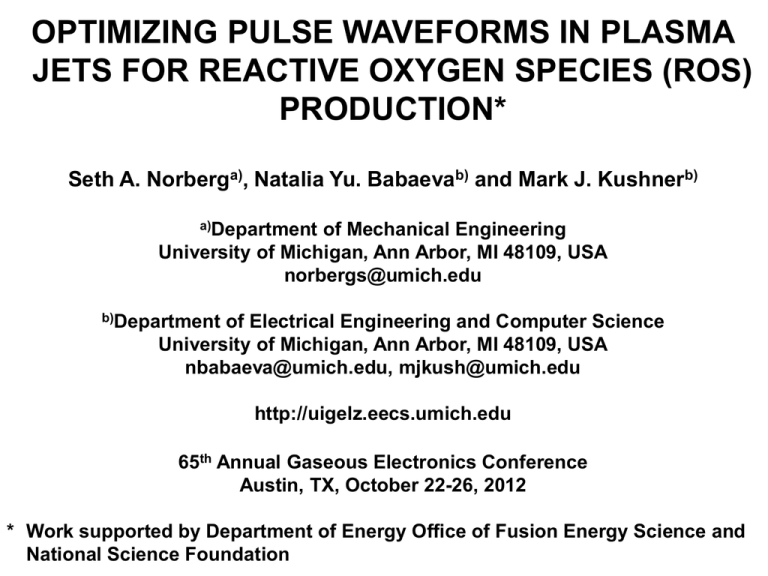
OPTIMIZING PULSE WAVEFORMS IN PLASMA JETS FOR REACTIVE OXYGEN SPECIES (ROS) PRODUCTION* Seth A. Norberga), Natalia Yu. Babaevab) and Mark J. Kushnerb) a)Department of Mechanical Engineering University of Michigan, Ann Arbor, MI 48109, USA norbergs@umich.edu b)Department of Electrical Engineering and Computer Science University of Michigan, Ann Arbor, MI 48109, USA nbabaeva@umich.edu, mjkush@umich.edu http://uigelz.eecs.umich.edu 65th Annual Gaseous Electronics Conference Austin, TX, October 22-26, 2012 * Work supported by Department of Energy Office of Fusion Energy Science and National Science Foundation AGENDA Atmospheric Pressure Plasma Jets (APPJ) Description of model Plasma jet model Propagation of plasma bullet Radical production at fringes of jets Planar plasma jet model Concluding remarks Special Acknowledgement – Prof. Annemie Bogaerts Mr. Peter Simon GEC2012 University of Michigan Institute for Plasma Science & Engr. ATMOSPHERIC PRESSURE PLASMA JETS (APPJ) Plasma jets provide a means to remotely deliver reactive species to surfaces. In the biomedical field, low-temperature non-equilibrium atmospheric pressure plasma jets are being studied for use in, Sterilization and decontamination Destruction of proteins Bacteria deactivation Plasma jets typically consist of a rare gas seeded with O2 or H2O flowing into room air. Plasma produced excited states and ions react with room air diffusing into plasma jet to generate ROS (reactive oxygen species) and RNS (reactive nitrogen species). In this talk, we present results from computational investigation of He/O2 plasma jets flowing into room air. GEC2012 University of Michigan Institute for Plasma Science & Engr. ATMOSPHERIC PRESSURE PLASMA JETS (APPJ) Coaxial He/O2 plasma jets into room air were addressed. Needle powered electrode with and without grounded ring electrode. In these configurations, plasma bullets propagate into a flow field. • Figures from X. Lu, M. Laroussi, and V. Puech, Plasma Sources Sci. Technol. 21 (2012) GEC2012 University of Michigan Institute for Plasma Science & Engr. FORMATION OF EXCITED STATES IN APPJ Prior experimental and modeling results have shown that jet produced excited states undergo reaction with air at boundary of jets. For example, excitation transfer from He* to N2 creates a ring of N2(C3π). Ref: G. V. Naidis, J. Phys. D: Appl. Phys. 44 (2011). GEC2012 University of Michigan Institute for Plasma Science & Engr. MODELING PLATFORM: nonPDPSIM Poisson’s equation: ( q j N j ) j Transport of charged and neutral species: N t Charged Species: = Sharffeter-Gummel Neutral Species: = Diffusion Surface Charge: j S q j S t j material Electron Temperature (transport and rate coefficients from 2-term spherical harmonic expansion solution of Boltzmann’s Eq.): 3 5 n e kT e S T e L T e kT e T e T e t 2 2 GEC2012 University of Michigan Institute for Plasma Science & Engr. MODELING PLATFORM: nonPDPSIM Radiation transport and photoionization: S m ( ri ) N m ( ri ) k mk Ak 3 N k r j ' G k r j ' , ri d r j ' G r j ' , ri Poisson’s equation extended into materials. q j j t j exp l surface ri lk N l r j 'd r j ' rj ' 2 4 r j ' ri Solution: 1. Unstructured mesh discretized using finite volumes. 2. Fully implicit transport algorithms with time slicing between modules. GEC2012 University of Michigan Institute for Plasma Science & Engr. nonPDPSIM: NEUTRAL FLUID TRANSPORT Fluid averaged values of mass density, mass momentum and thermal energy density obtained using unsteady, compressible algorithms. ( v ) ( inlets , pumps ) t v NkT v v t c p T t qi N i Ei i T v c p T Pi v f R i H i i ji E i Individual neutral species diffuse within the single fluid, and react with surfaces Ni t GEC2012 ( N i v ) D i N i S i University of Michigan Institute for Plasma Science & Engr. PLASMA JET: GEOMETRY AND CONDITIONS Quartz tube with inner pin electrode and grounded rink electrode. Cylindrically symmetric He/O2 flowed through tube. Air flowed outside tube as shroud. -30 kV, 1 atm He/O2 = 99.5/0.5, 20 slm Surrounding humid air N2/O2/H2O = 79.5/20/0.5, 0.5 slm Fluid flow field first established (5.5 ms) then plasma ignited. Ring electrode is dielectric in analyzed case. GEC2012 University of Michigan Institute for Plasma Science & Engr. PLASMA JET: DIFFUSION OF GASES Flow field is established by initializing “core” of He in room air, and allowing gas to intermix. Room air is entrained into jet, thereby enabling reaction with plasma excited species. The mixing layer is due to diffusion at the boundary between the He/O2 and air. He/O2 = 99.8/0.2, 20 slm Air = 0.5 slm Animation Slide MIN GEC2012 Log scale University of Michigan MAX Institute for Plasma Science & Engr. PLASMA JET One DC pulse, 25 ns rise time, -30 kV, 1 atm, He/O2 = 99.8/0.2, no ground electrode. Plasma bullet moves as an ionization wave propagating the channel made by He/O2. Te has peak value near 8 eV in tube, but is 2-3 eV during propagation of bullet. [e] and ionization rate Se (location of optical emission) transition from hollow ring to on axis. Bullet stops when mole fraction of He is less than 40%. Plasma has run for 66 ns. Animation Slide GEC2012 MIN Log scale University of Michigan MAX Institute for Plasma Science & Engr. ELECTRON DENSITY One DC pulse, 25 ns rise time, -30 kV, 1 atm, He/O2 = 99.8/0.2, no ground electrode. Plasma has run for 66 ns. Electron density transitions from annular in tube and exit to on axis. As air diffuses into He, the self sustaining E/N increases, progressively limiting net ionization to smaller radii. Penning ionization (He* + N2 He + N2+ + e) at periphery aids plasma formation, but air diffusion and increase in required E/N dominates. MIN GEC2012 Log scale MAX Animation Slide University of Michigan Institute for Plasma Science & Engr. PLASMA BULLET SHAPE A few slides on “waveform” One DC pulse, 25 ns rise time, -30 kV, 1 atm, He/O2 = 99.8/0.2, no ground electrode. Flow at 5.5 ms. Plasma has run for 66 ns. Bullets propagate at speeds similar to conventional ionization waves (107 cm/s). • GEC2012 Figure from X. Lu, M. Laroussi, and V. Puech, Plasma Sources Sci. Technol. 21 (2012) University of Michigan Institute for Plasma Science & Engr. ROS/RNS PRODUCED IN PLASMA RONS produced by plasma jet plasma include NO, OH, O, O3 and O2(a). (Densities shown are from 1 pulse.) O2(a) and O are formed in tube. NO and OH are in plume, resulting from diffusion of humid air into jet. Significant RONS production outside core partly due to photoionization & photodissociation. 1 atm, He/O2 = 99.8/0.2, -30 kV, 20 slm, no ground electrode. Animation Slide GEC2012 MIN Log scale MAX University of Michigan Institute for Plasma Science & Engr. ROS PRODUCED IN PLASMA ROS densities increase along the jet with increase of diffusion of air into the jet. O2(a) and O3 are longed lived (for these conditions), and will accumulate pulseto-pulse, subject to advective flow clearing out excited states. 1 atm, He/O2 = 99.8/0.2, -30 kV, 20 slm, no ground electrode. GEC2012 University of Michigan Institute for Plasma Science & Engr. RNS DENSITIES RNS are created through the interaction of the He/O2 jet with air. N2* [N2(A) and N2(C)] have peak densities of 1014 cm-3 (from 1 pulse). Due to high thresholds of these electron impact processes, densities are center high where Te is maximum in spite of higher density of N2 near periphery. 1 atm, He/O2 = 99.8/0.2, -30 kV, 20 slm, no ground electrode. Animation Slide GEC2012 MIN Log scale MAX University of Michigan Institute for Plasma Science & Engr. RNS PRODUCED IN PLASMA Annular to center peaked RNS densities from exit of tube to end of plume. 1 atm, He/O2 = 99.8/0.2, -30 kV, 20 slm, no ground electrode. GEC2012 University of Michigan Institute for Plasma Science & Engr. Cathode PLANER GEOMETRY: Te SEQUENCE Fluid module is run first (8 ms) to establish steady-state mixing of Helium and ambient air. Then, a pulse of different rise time (tens of ns) is applied. GEC2012 1 atm, He/O2 = 99.8/0.2, 35 kV, 20 l/min Surrounding humid air N2/O2/H2O = 79.5/20/0.5 Pulse rise time 25 ns University of Michigan Institute for Plasma Science & Engr. EFFECT OF PULSE RISE TIME Rise time 75 ns Rise time 25 ns Bullet formation time inside tube 7 ns Bullet formation time inside tube 22 ns Bullet formation time inside tube 47 ns Propagation time 13 ns Propagation time 17 ns Propagation time 33 ns Cathode Cathode Rise time 5 ns Bullet formation time inside the tube and propagation time increases with the increase of the pulse rise time. Shorter rise time results in more intensive IW: higher electron impact sources Se and electron temperature Te 1 atm, He/O2 = 99.8/0.2, 35 kV, 20 l/min, surrounding humid air N2/O2/H2O = 79.5/20/0.5 GEC2012 University of Michigan Institute for Plasma Science & Engr. CONCLUDING REMARKS Conducted a proof of concept for modeling the plasma bullet and gained information about radical species in the trail of the bullet. Significant densities of reactive oxygen and nitrogen species are created by the dry chemistry of the atmospheric pressure plasma jet. Future modeling work includes: Plasma bullet behavior for different polarities. Varying discharge geometry to reproduce results. Different mixtures of feed gas to optimize desired ROS/RNS production. Impact effects of jet on a surface. GEC2012 University of Michigan Institute for Plasma Science & Engr. Back Up Slides 1. 2. 3. DEPENDENCE ON VOLTAGE WAVEFORM 4. • In each plot, electron temperature is used to represent the plasma bullet. • 1 atm, He/O2 = 99.8/0.2, 20 slm 1. 25 ns rise to -30 kV pulse with no ground electrode 2. 25 ns rise to -10 kV pulse with ground electrode 3. 25 ns rise to -30 kV pulse with ground electrode 4. 50 ns rise to -30 kV pulse with ground electrode. Animation Slide GEC2012 MIN Log scale MAX University of Michigan Institute for Plasma Science & Engr.
